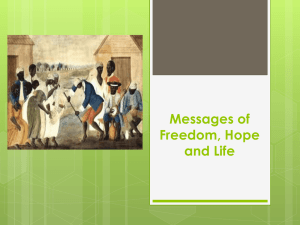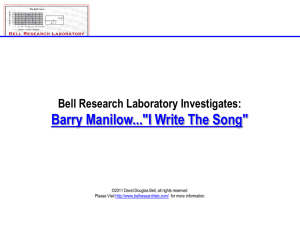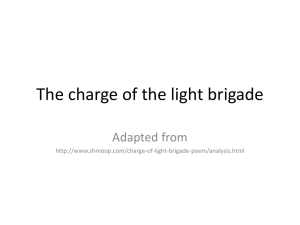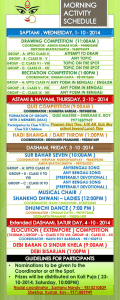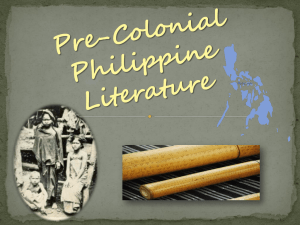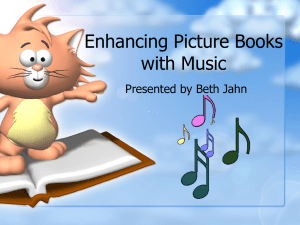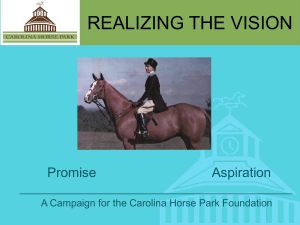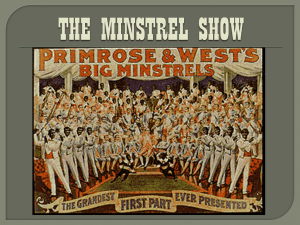usingsongstoteachhistory_mriggs
advertisement
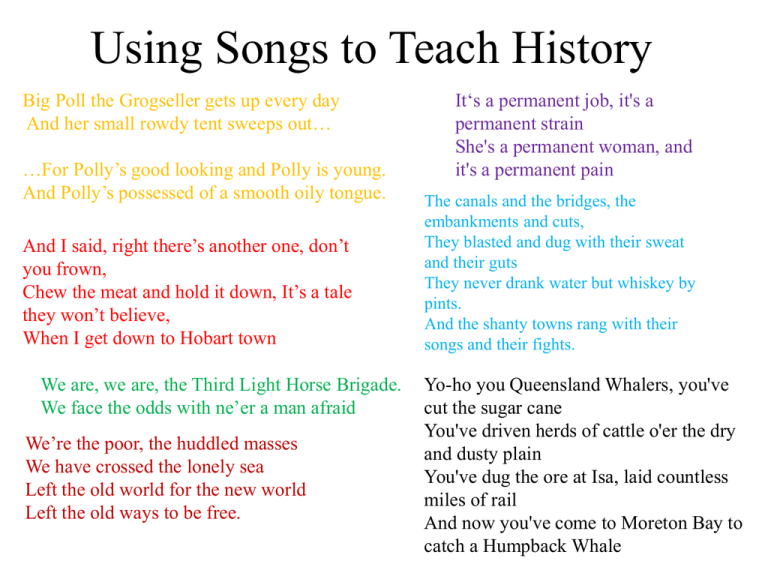
Using Songs to Teach History Big Poll the Grogseller gets up every day And her small rowdy tent sweeps out… …For Polly’s good looking and Polly is young. And Polly’s possessed of a smooth oily tongue. And I said, right there’s another one, don’t you frown, Chew the meat and hold it down, It’s a tale they won’t believe, When I get down to Hobart town We are, we are, the Third Light Horse Brigade. We face the odds with ne’er a man afraid We’re the poor, the huddled masses We have crossed the lonely sea Left the old world for the new world Left the old ways to be free. It‘s a permanent job, it's a permanent strain She's a permanent woman, and it's a permanent pain The canals and the bridges, the embankments and cuts, They blasted and dug with their sweat and their guts They never drank water but whiskey by pints. And the shanty towns rang with their songs and their fights. Yo-ho you Queensland Whalers, you've cut the sugar cane You've driven herds of cattle o'er the dry and dusty plain You've dug the ore at Isa, laid countless miles of rail And now you've come to Moreton Bay to catch a Humpback Whale All historical sources can be used in the same ways. Songs are no different with the bonus - they are Entertaining INFORMATION Implicit/Explicit Facts (true or otherwise) NB To reduce the size of the Powerpoint many songs and videos have been removed and replaced with a comment in blue to stating what would have been shown. INSIGHT/EMPATHY What was it like? BIAS Everyone has bias. Whose Point of View? MYTHS Reinforcing or Busting? PIQUING INTEREST Why is it so? NUMERACY SKILLS Graphs and Statistics. LISTENING SKILLS Active listening, summarising, rephrasing. Also in blue are some explanations of how I use each slide in class. CLASSROOM USE Background music while students are working. Medieval songs. Illustrating the songs using PowerPoint or Moviemaker. Adding facts/quotes etc. to the images. Using the songs to develop literacy /numeracy Finding the meaning of new words. Exploring the numbers in songs. Listening Skills Active Listening, Summarising, Rephrasing, New Experiences. Using the songs to focus further research. Question sheets leading students to do further research. Analysing songs in detail. Implicit and explicit information. Background music while students are working. Medieval songs. QUEEN JANE (Lionel Long) One of the few folk songs about Royalty One of the few that lasted centuries and was performed by Joan Baez, Lionel Long et al. WANTON FLING (Whistlebinkies) One who attends a penny wedding, but without paying anything, and therefore has no right to take any share of the entertainment; a mere spectator who is, as it were, left to sit on a bench by himself, and who, if he pleases, may whistle for his own amusement". QUAN VEY LA LAUZETA Medieval Babes Illustrating the songs using PowerPoint or Moviemaker. Adding facts/quotes etc. to the images. Show video of “Balaena”. Showing how a song can be illustrated with historic images. http://www.youtube.com/watch?v=K6OYb_7bhME Using the songs to focus further research. Question sheets leading students to do further research. Analysing songs in detail. Implicit and explicit information. Using the songs to develop literacy /numeracy Finding the meaning of new words. Exploring the numbers in songs. Listening Skills Active Listening, Summarising, Rephrasing, New Experiences. Show videos from History Teachers Youtube channels. They are a psi of History teachers from Hawaii the create modern type video clips by using modern songs but rewording them to cover a particular part of history. http://www.youtube.com/user/historyteachers PAY The sailor in “Maggie May” was paid £2/10/- a month. Use http://www.nationalarchives.gov.uk/currency/ The following are samples of questions given to students when investigating particular songs. What is £2/10/- worth in today’s money? ___________________________________________________________________________________ What could it buy in the 1830s/1840s? ___________________________________________________________________________________ ___________________________________________________________________________________ Given that the sailor would not have had to buy any food or accommodation whilst at sea: Is £2/10/- a month a good wage? Is it historically accurate or does it just fit the meter of the song? ___________________________________________________________________________________ ___________________________________________________________________________________ ___________________________________________________________________________________ ___________________________________________________________________________________ Jim Jones at Botany Bay Jim Jones is also one of the oldest Australian songs. Poaching was common crime in England so poachers should make a large proportion of convicts. Work out the percentage of convicts who were Poachers Convicts transported for Poaching was 300 out of 165 000 total convicts. 300 ÷165,000 x 100 ÷ 1 = _____0.18______% OR Does this make Jim Jones a “Typical” convict? Why? ________________________________________________________________________ ________________________________________________________________________ Is 500 soldiers on the convict ship a realistic number? Why? ________________________________________________________________________ ________________________________________________________________________ FLOGGING During all the years of transportation statistically 25% of convicts were flogged with a an average of 46 lashes. Although harsh by today’s standards, flogging was a common punishment in the Navy and Army as well. A flogged man would be back at work within a few days to a week. Large sentences of 150-200+ were often delivered over several days or it would kill the prisoner – this sometimes being the intention. Do the Maths 25% x 165000 convicts = 41 250 convicts flogged. Multiply the number of convicts by 46 to see the total lashes delivered. 46 x ___1 897 500_________ = total lashes. There is 1,000,000 seconds in about 11.5 days. At one per second – approximately how long would it take to deliver the total number of lashes? ___________20.7____________ Days _____3___________ Weeks The whip used to flog prisoners was a Cat o’ Nine Tails. That is, it was made up of nine leather strips. Some were made with three knots or pieces of lead at the end of each cord. Multiply the total number of lashes by 9 to see how many lashes were really delivered. __________17 077 500_______________ Using the songs to focus further research. Question sheets leading students to do further research. DATING SONGS One way to date a song if it is not known for certain is to look for words/phrases that were new at the time. One is Sydney Cove which was settled in 1788. So the song must be younger than 1788. The other is “Bobby” for a policeman. Why was the policeman called a “Bobby”(they still are in England)? _______________________________________________________________________________________________ _______________________________________________________________________________________________ When were the first Police called “Bobbies”? This will give another key date. _______________________________________________________________________________________________ _______________________________________________________________________________________________ When did transportation to Sydney and Van Diemen’s land stop? _______________________________________________________________________________________________ _______________________________________________________________________________________________ These will only give you the maximum age of the song. It could have been written yesterday. What other clues are there to suggest the song is old? _______________________________________________________________________________________________ _______________________________________________________________________________________________ How else could you find the age of song if it wasn’t dated? _______________________________________________________________________________________________ _______________________________________________________________________________________________ Analysing songs in detail. Implicit and explicit information. INFORMATION Implicit/Explicit Facts (true or otherwise) Numeracy Skills. “And two pound ten a month was all my pay” (Maggie May) Is this a realistic wage? “They'll be down in Stanley's hock-shop number nine” (Maggie May) The sailor in the song has his clothes stolen by Maggie. Is this the first time she has done it? “But the soldiers on our convict ship were full five hundred strong” (Jim Jones at Botany Bay) Unlikely, the convict ships held only a few hundred all up. INSIGHT/EMPATHY What was it like? It's very unpleasant as I remember To sit in the stocks in the month of December The wind is so hot with the sun right o'er Sure, it's no place for a lover. "It's worse than the treadmill", says I, "Mr Dunn, For to sit here all day in the heat of the sun", "Either that or a dollar", says he, "for your folly". "If I had a dollar I'd drink it with Molly." (Currency Lasses) MYTHS Reinforcing or Busting? “For you stole Trevelyan's corn, so the young might see the morn.” (Fields of Athenry) “We’re horsemen from Australia of the good old British breed, We rallied to the colours when we heard the Empire’s need” (Marching Song of the 3rd Light Horse Brigade) Sergeant Small When we got into Roma I kept my head down low I heard a voice say "Any room Mate?" I answered "Plenty Bo" "Come out of there my noble man" came the voice of Sergeant Small "I have trapped you very nicely - you've ridden for a fall” This story travelled all over Australia but has very little truth and may have happened but not as regularly as the song suggests. The Railways and the Police in general were fairly sympathetic to the swagmen. When they weren’t sympathetic there was no need for disguises. A Tale They Won’t Believe. We left Macquarie Harbour it was in the pouring rain None of us quite sure if we would see England again Some fool muttered death or liberty There was six of us together a jolly hungry crew And as the days went by you know our hunger quickly grew Some fool muttered death or liberty So that night we made fires out of twigs and out of bark And our stomaches they were grumbling all through the night so dark We were only trying to keep our selves alive But when the sun came up next morning well the six had turned to five And I said, right there’s another one, don’t you frown, Chew the meat and hold it down, It’s a tale they won’t believe, When I get down to Hobart town All five of us were nervous and I'll tell you that’s a fact But you should have seen the bastard who was carrying the axe He was a sick man he had murder in his heart And then we reached the Franklin River, and it took two days to cross We were wet and almost starving. And for food we’re at a loss We were hungry men with murder on our minds. So that night we made a fire out of twigs and out of bark And our stomachs they were rumbling all through the night so dark, And they were making noises that death could not ignore And when the sun came up next morning, The five had turned to four! And I said, right there’s another one, don’t you frown, Chew the meat and hold it down, It’s a tale they won’t believe, When I get down to Hobart town BIAS Opinions are like watches - Everyone has one and everyone thinks theirs is right. “They'll flog the poaching out of you out there at Botany Bay” (Jim Jones at Botany Bay) “I'll kill the tyrants one by one and shoot the floggers down” (Jim Jones at Botany Bay) Analysing songs in detail. Implicit and explicit information. Showing how a song came into being. World War I (1914-1918) • An overview of the causes of World War I and the reasons why men enlisted to fight in the war. • The places where Australians fought and the nature of warfare during World War I, including the Gallipoli campaign. • The impact of World War I, with a particular emphasis on Australia (such as the use of propaganda to influence the civilian population, the changing role of women, the conscription debate) • The commemoration of World War I, including debates about the nature and significance of the Anzac legend. The 3rd Light Horse Brigade The Nek Consequences Song and Statistics The First Wave – 8LHR Show video of attack at the Nek from the film “Gallipoli” Anthill – “The Attack Must Proceed” Show video of Anthill saying the “Attack Must Proceed” from the film “Gallipoli” 8th & 10th Light Horse Regiments 8th Regiment Deaths 10th Regiment Deaths Total 8th & 10th Deaths Give the students the raw data for these graphs and get them to graph it themselves The Nek Rest of the War 8th & 10th Light Horse Regiments 8th Regiment Wounded 10th Regiment Wounded The Nek The Nek Rest of the War Rest of the War Give the students the raw data for these graphs and get them to graph it themselves 8th & 10th Light Horse Regiments 8th Regiment The Nek Give the students the raw data for these graphs and get them to graph it themselves 10th Regiment The Nek Total 8th & 10th The Nek Casualties NonCasualties Major General John Macquarie Antill, Major General John Macquarie Antill, Jr. CB, CMG (26 January 1866 – 1 March 1937) During the fierce fighting at The Nek, Antill, was in temporary command of the Brigade, he refused a request from the commander of the 10th Light Horse to cancel the third wave. Colonel Hughes had gone forward to call off the attack, leaving Antill in charge. Due to a communications breakdown, Antill believed Hughes had gone forward to lead the Brigade forward and therefore ordered the attack to continue. Hughes reached the line in time to call off the fourth wave. On 1 January 1916, Antill was promoted to colonel and temporary brigadier general and confirmed in command of 3rd Light Horse. The brigade was placed in the rear and for a time took over part of the defence of No. 2 Section of the Suez Canal defences. In an effort to rebuild the 3rd Light Horse Brigade after the withdrawal from Gallipoli in December 1915, the GOC, Brigadier General Antill turned to music to assist in the bonding process. Selecting the music to the popular American Civil War tune, "Marching through Georgia", was the easy part. To play the tune, the 8th Light Horse Regiment band was reconstituted and began rehearsing on 12 January 1916. Within in two days, the band gave their first performance. To generate additional enthusiasm, on 16 January 1916, Antill announced a competition for an aspiring poet within the Brigade to put words to the tune which were distinctly Australian. As an added incentive, a prize of one guinea [£1/1/- or in 2008 AUD, about $420] was offered for the best entry. The prize was claimed a week later. The song is on the next page. In August was the brigade released to join the Anzac Mounted Division at Romani, too late to be decisive, and nearly too late to join the battle at all. Antill's only major action during the battle was at Bir el Abd on 5 August 1916. Antill began by piercing the Turkish flank and overrunning the Turkish position at Hamisah, taking some 425 prisoners. While reforming after the engagement his regiments came under light shell fire, and Antill decided to fall back. He appeared to have lost his nerve. Antlll's actions cost Major General Chauvel vital hours and led to the removal of 3rd Light Horse from the line. Only days after Romani, General William Birdwood sent a message requesting Antill take command of an infantry brigade on the Western Front. Antill elected to go and handed over command of his brigade on 9 August. He was immediately given command over the 2nd Infantry Brigade. Antill became ill and was evacuated sick to England in November 1916. He returned to France on 20 March 1917 and took command of the 16th Infantry Brigade which was forming in England as part of the new 6th Division. Listen to the Song click on the icon Marching Song of the 3rd Light Horse Brigade We’re horsemen from Australia of the good old British breed, We rallied to the colours when we heard the Empire’s need, You bet we’re out to play the game, and if we don’t succeed, We’ll join our mates who took the count before us. CHORUS: We are, we are, the Third Light Horse Brigade. We face the odds with ne’er a man afraid, We lost our gallant comrades and there’s many a score unpaid, Undaunted still we’re out for what’s before us. Eighth, Ninth, Tenth, and Signallers, Field Ambulance and Train We did our bit at Anzac, where we’d like to go again, For though we got it in the NEK, we’ll fight with might and main, To square our mates who took the count before us. Send the news to Kitchener, tell Birdwood with a snap, Say that we Australian boys are busting for a scrap. We want to tackle Germany and wipe her off the Map, Then toast our mates who took the count before us. Marching Song of the 3rd Light Horse Brigade 1. Why do you think Anthill chose a song to unite the Brigade? 2. Why did the Brigade need to unite? Hint how much of the original Brigade was left after Gallipoli? 3. What part of the song refers to the battle at the Nek? 4. Why do you think the author included such a disaster? 5. A Guinea was a day’s pay for a trooper in the Light Horse. Why do you think Anthill offered such a big prize? 6. “Eighth, Ninth, Tenth, and Signallers, Field Ambulance and Train.” What do each of these mean? 7. “Send the news to Kitchener, tell Birdwood with a snap” Who was Kitchener and Birdwood? 8. “We’re horsemen from Australia of the good old British breed”. Why British not Australian? 9. “We rallied to the colours when we heard the Empire’s need”. What does “colours” mean in this line. 10. Why do you think Anthilll had “lost his nerve”. 11. Why do you think he was moved to the Western Front where he would be in charge of infantry and not Light Horse? 12. Find out more about the battle of Hamisah. Why was Anthill criticised for his actions? What is needed for a Light horse commander that Anthill lacked? Thirty Ton Line Tugs and Tragedy With this song I start with only the song and no lyrics. I then give the students the lyrics and they have to do the research to find out where the song was set, what event it describes and how accurately. They use this information to create a 35th anniversary news paper lift out. Thirty ton line Don Henderson Purpose-built tugs with line boats attending Berth big, bulk coal-carriers in open seas, To fulfill that function, the union contended Required four deckhands, Fenwick’s said three. Three deckhands and a motorman just couldn’t handle Sixteen inch polyprop double dead-eyes. When the tow-hook was blacked, the company gambled On a tension winch, ten inch calm sea compromise. Broadsound, Belyando, Nebo, Serina The sea snaps your hawsers like thin strands of twine. Broadsound, Belyando, Nebo, Serina Hundred-tons bollard-pull thirty-ton line. The Martha was cleared just as our line had parted, The Academy Star was on wharf number one, Though the help we could offer was nought but a token In her state, that help would be better than none. Time and again we tried to position To get her away with all possible speed, But with jury-rigged lines and in such bad conditions, Two deckhands and a motorman couldn’t succeed. Only part loaded and riding high in the water The Academy Star could not be controlled, The strong on-shore wind had her hard on the quarter She slammed at the pylons ‘till her hull had holed. But still Utah’s bosses and those who do their will, Put tugs to sea short on gear, undermanned; One million dollars will be the repair bill, They’d pay that in preference to one more deckhand. At two in the morning we made fast the Martha, At nine the Academy Star had been berthed; Then all tugs and line-boats returned to the harbour Their work being finished the crews then dispersed. The red words are not highlighted for the students, but But at five the same evening storm warnings were sounding show the key bits that tell where the song was set. Cyclone approaching, no time for delay, Cyclones occur in Australia At their berths the big bulkies were taking a pounding, Hay Point is in MacKay Qld Broadsound and Belyando must get them away. To Hay Point all on the two tugs went thrashing, Got lines in the Martha at wharf number two, Though twelve foot green water on their decks was crashing The order “Use maximum power” had come through. With the whole hull vibrating and the tension winch screaming Then came the moment all tug-men dread, The sudden lurch forward and the broken line whipping The thoughts of old ship mates, the injured, the dead. Broadsound, Belyando, Nebo, Serina are the names of the tugboats and the first two still exist. They are also suburbs of Mackay. From there the Port of Mackay has a timeline that shows cyclone damage of $1 000 000 in 1979 after Cyclone Kerry. From here is relatively easy to research “Cyclone Kerry”. The song was written accurately and was purposely biased and pro union. http://pmtranscripts.dpmc.gov.au/transcripts/00004975.pdf Canberra Times 2 March 1979 Cyclone Kerry Kerry crossed the coast near Proserpine. In Mackay one house suffered extensive damage and 26 houses lost parts of their roofs. A large section of roof was torn off a warehouse and caravans were damaged. Power lines were blown down. At Seaforth 16 m trees were uprooted. The Mackay Met Office recorded a maximum wind gust of 76 knots while the highest 10 minute mean wind was 50 knots. Huge seas caused 1 million 1979 dollars damage to boats in the harbour. On Brampton Is. the staff quarters were unroofed and many trees were blown down and a storm surge there brought the sea one metre above the highest recorded tide level. Hayman Is also reported a one metre storm surge. The Mackay Eungella road was cut by fallen trees and landslides and floods cut the Bruce Highway. The Mackay wave recording station measured significant wave heights to 4.02 metres maximum height 5.91metres and peak energy period 9.19 seconds http://hardenup.org/be-aware/weather-events/events/1970-1979/cyclone-kerry.aspx GEOGRAPHY Cyclone season - Graeme Connors Illustrate with pictures and facts about cyclones. Use video about cyclone Tracy for extra information. Putamayo Music Music from the Tea Lands Music from the Coffee Lands Music from the Chocolate Lands http://www.putumayo.com/ Music as background facts and pictures about the manufacture culture and working life behind these products. Some of My Favourites Currency Lasses A light hearted look at love and life as a convict. New Exhibits During the General strike of 1917. Strike breakers were house at the Sydney Zoo. This song is from the point of view of the Monkey and fox at the Zoo. Gum Tree With Six Branches One of the few Federation songs worth remembering. Others were a bit over the top. Big Poll the Grog Seller A positive song about women and one of their roles on the goldfields. I’ve Been to Australia O A tongue twisting look at Gold Field prices. Mark Riggs Maffra Secondary College riggs.mark.a@edumail.vic.gov.au Please email me if you need any resources or have any questions.
